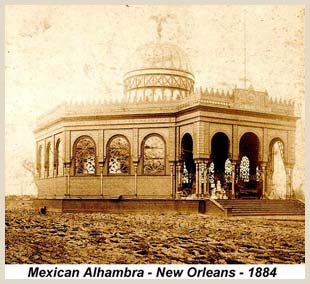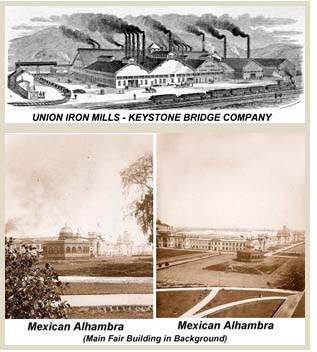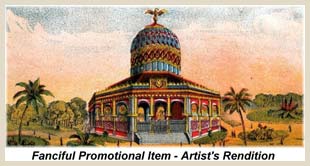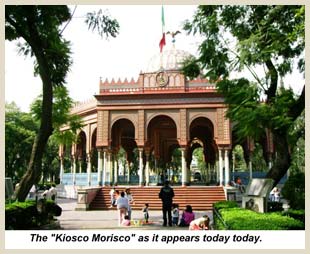 |
Malcolm Lubliner ~ Photography & Art Since 1965 |
| Historic Mexico | About Historic Mexico | Photographs Page 1 | Photographs Page 2 |
“Lottery
Building (Kiosco Morisco - Moorish Kiosk)” |
|||||||||
The following essay is about a beautiful kiosk-like structure that George P. Thresher photographed around the turn of the twentieth century called the "Kiosco Morisco" (Moorish Kiosk). Mr. Thresher labeled the photo "1177 Lottery Bldg" because for a brief time the Mexican National Lottery was drawn there. The structure has had an illustrious history and continues to serve today as a popular Mexico City landmark. This kiosk was designed by a prominent engineer named José Ramón Ibarrola as an exhibit for the New Orleans Universal Cotton Exposition and World's Fair which ran from December 16, 1884 to June 1, 1885. One of the features of the Kiosco Morisco is that it was made from cast iron pieces that could be taken apart and reassembled with relative ease making the kiosk portable and available for reuse at other locations. Many people think that the Moorish design was adopted because of the Moorish influence on Mexican architecture but in reality the theme was chosen because interest in the Middle East was very high at the time and the Moorish designs at the Philadelphia Centennial Exhibition just a few years earlier in 1876 had been well received. At the New Orleans fair the kiosk was called the Mexican Alhambra Palace because the style of architecture so closely resembled the style of the Alhambra Palace in Granada, Spain. It was also sometimes referred to as the "Octagonal Building" because its walls were in the form of an octagon or eight sided figure. After the New Orleans Fair the kiosk was dismantled sent to Mexico City and erected on the south side of the Parque Alameda Central. There the Kiosco Morisco stood until 1910 when it was moved to make way for a semicircular memorial known as the Hemiciclo Juárez, which is dedicated to the former Mexican president, Benito Juárez. The Kiosco Morisco in turn was moved to The Alameda de Santa María la Ribera where it stands today.
Cast iron, the material used for the Kiosco Morisco, was a natural for that time. Cast iron was the metal of choice throughout the second half of the 19th century. Not only was it a fire resistant material but large structures could be produced with cast iron at less cost than other materials such as brick or stone and cast iron structures could be erected with speed and efficiency. Cast iron is also more resistant to corrosion than either wrought iron or steel and while molten, cast iron is easily poured into molds, making it possible to create nearly unlimited decorative and structural forms. For this reason it was particularly useful in creating the intricate design patterns on the Kiosco Morisco. Apparently José Ramón Ibarrola, the designer, was an acquaintance of Andrew Carnegie, the iron and steel magnate. The sections of the Kiosco Morisco were cast at the Union Mills Foundry of the Keystone Bridge Company which was one of Andrew Carnegie's companies. As a matter of fact both Mr. Carnegie and Señor Ibarrola received honorary degrees together in 1906 from the University of Pennsylvania.
At the New Orleans Exhibition the Kiosco Morisco (Mexican Alhambra) was situated near the southeast corner of the Main Building. Over the entrance to the Kiosco Morisco hung a prominent sign containing the Mexican national seal and the words, "Mexican Mining Pavilion", in gilded letters. Within the pavilion were large glass display-cases, arranged in two circles, in which were placed a multitude of rare minerals from each of Mexico's mineral States. The States having the finest displays were Sinaloa, Chihuahua, Zacatecas, Guanajuato and Hidalgo, whose immense resources in iron, copper, zinc and lead, as well as in the more precious metals of gold and silver, were well represented. Precious stones were also shown and in particular opals from the state of Queretaro. Beneath the dome, at the center of the pavilion, was a half a ton of silver displayed as a mountain, while collections of various tropical shrubs were placed beneath the colored-glass windows surrounding the building. A distinguished mining engineer and very accomplished individual by the name of Gilberto Crespo y Martínez was in charge of the displays in Mexican exhibit. In addition to the Kiosco Morisco, a wooden building was constructed to house both a Mexican martial band and a cavalry squadron. It was reported that the Kiosco Morisco and the Mexican band were the most popular foreign attractions at the fair. The Kiosco Morisco was declared a National Artistic Monument by the Mexican Instituto Nacional de Antropología e Historia en 1972 and underwent a complete restoration in 2003. It is located at the Alameda de Santa María la Ribera which is bounded by the streets Salvador Díaz Mirón, Dr. Atl, Manuel Carpio, and Torres Bodet, in the Colony of Santa María la Ribera. It is stunningly beautiful and well worth a visit. Bob Mrotek can be reached by e-mail at bob.mrotek@gmail.com or at info@cityvisions.com. |
|||||||||
| Home | Nature & Human Nature | Automotive Landscape | Artists Portraits | Historic Mexico | Resumé | Contact |


 Although there was a small Mexican exhibit at the Philadelphia Centennial
in 1876, Mexico's attendance at New Orleans constituted the first
major effort to portray itself as a modern nation on the world stage.
Some people claim that the Kiosco Morisco was used at the Exposición
Internacional de París in1889 and the Louisiana Purchase Exposition
World's Fair in St. Louis in 1904 but I can find no evidence of this.
Mexico did participate in these fairs but the exhibits were larger
and completely different. I believe that one of the reasons that
people think the Kiosco Morisco was used again in Paris and St. Louis
was that flattering promotional material from the New Orleans exhibition
was used to create advance promotional material for future fairs.
Mexico also participated in the Chicago exhibition of 1893 and the
Buffalo exhibition of 1901 but for economic reasons it was on a much
smaller scale.
Although there was a small Mexican exhibit at the Philadelphia Centennial
in 1876, Mexico's attendance at New Orleans constituted the first
major effort to portray itself as a modern nation on the world stage.
Some people claim that the Kiosco Morisco was used at the Exposición
Internacional de París in1889 and the Louisiana Purchase Exposition
World's Fair in St. Louis in 1904 but I can find no evidence of this.
Mexico did participate in these fairs but the exhibits were larger
and completely different. I believe that one of the reasons that
people think the Kiosco Morisco was used again in Paris and St. Louis
was that flattering promotional material from the New Orleans exhibition
was used to create advance promotional material for future fairs.
Mexico also participated in the Chicago exhibition of 1893 and the
Buffalo exhibition of 1901 but for economic reasons it was on a much
smaller scale. 

